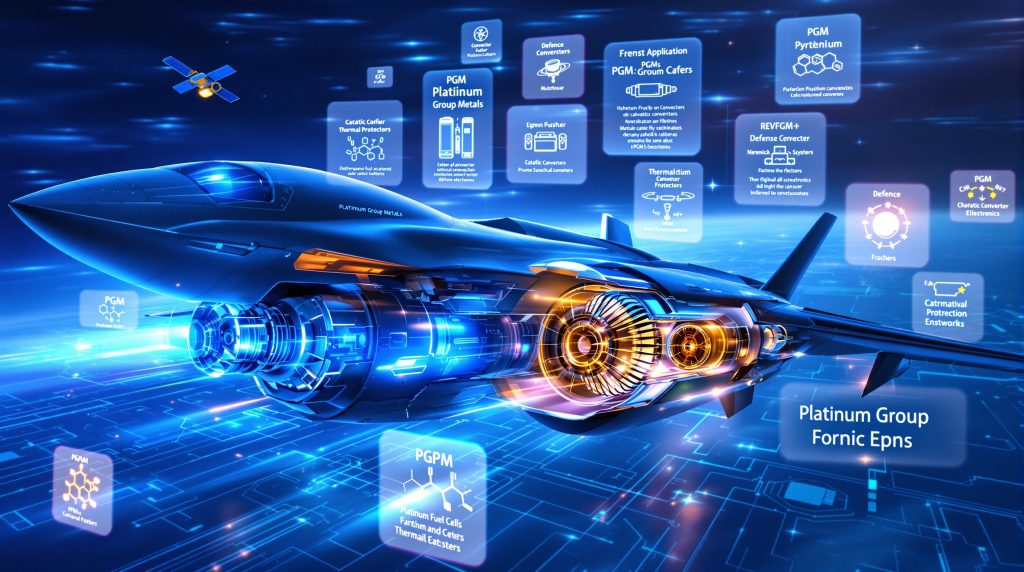Platinum Group Metals in Defense and Aerospace: Strategic Applications and Market Outlook
Platinum Group Metals (PGMs) have emerged as cornerstone materials in modern defense and aerospace systems, providing unique capabilities that enable technological advancement in some of the most demanding environments on Earth and beyond. These rare metals combine exceptional properties that make them virtually irreplaceable in critical applications where reliability, durability, and performance under extreme conditions are non-negotiable requirements.
What Are Platinum Group Metals (PGMs)?
Platinum Group Metals comprise six chemically similar elements: platinum, palladium, rhodium, ruthenium, iridium, and osmium. These metals share remarkable physical and chemical characteristics that set them apart from common industrial metals, including extraordinary resistance to corrosion, exceptional catalytic properties, and extremely high melting points.
Unlike abundant industrial metals such as iron or aluminum, PGMs exist in minuscule concentrations within the Earth's crust—often less than one part per million. This scarcity, combined with their concentration in just a few geographical regions globally, elevates their strategic importance and potential supply vulnerability.
The Six Critical PGM Elements
Each PGM brings unique properties to defense and aerospace applications:
- Platinum: Features exceptional catalytic properties and oxidation resistance even at high temperatures (melting point: 1,768°C)
- Palladium: Offers hydrogen absorption capabilities and electrical conductivity (melting point: 1,554°C)
- Rhodium: Provides extreme hardness and reflectivity (melting point: 1,964°C)
- Ruthenium: Delivers excellent wear resistance and electrical properties (melting point: 2,334°C)
- Iridium: The most corrosion-resistant metal known, with exceptional hardness (melting point: 2,466°C)
- Osmium: The densest naturally occurring element (melting point: 3,033°C)
This combination of properties makes PGMs indispensable in environments where extreme temperatures, corrosive conditions, and the need for catalytic activity intersect—precisely the conditions found in many defense and aerospace applications.
Strategic Importance in Modern Defense Systems
Defense departments worldwide classify PGMs as defence critical materials due to their irreplaceable role in advanced weaponry, communications systems, and aerospace applications. Their concentrated production—primarily in South Africa, Russia, and North America—creates supply vulnerabilities that defense planners must actively manage.
Many nations maintain strategic reserve of these metals specifically for defense applications, recognizing that commercial market availability cannot be guaranteed during geopolitical disruptions. These stockpiling initiatives help insulate critical defense production from market volatility but also influence global pricing and availability for other sectors.
How Are PGMs Transforming Defense Applications?
PGMs enable technologies that provide tactical advantages across land, sea, air, and space domains. Their unique properties make them essential components in systems where failure is not an option.
Advanced Vehicle and Aircraft Systems
Military vehicles rely heavily on PGMs for both performance and protective functions:
- Catalytic converters using platinum reduce emissions from military vehicles, meeting increasingly stringent environmental standards while maintaining operational capability
- Thermal signature suppression technology utilizing platinum coatings reduces vulnerability to infrared detection and heat-seeking weaponry—a critical survival feature in modern combat environments
- Temperature-sensing components made from platinum-rhodium alloys provide precise monitoring in extreme-temperature environments like jet engines and rocket motors
- Heat-resistant components incorporating various PGMs enable operation in conditions where conventional materials would fail, extending operational capabilities
These applications directly enhance battlefield survivability while enabling platforms to operate in more extreme environments than would otherwise be possible.
Electronic and Communications Systems
Modern warfare depends on reliable electronics and secure communications, areas where PGMs play crucial roles:
- Ruthenium-based chip resistors provide stability in military-grade electronics exposed to environmental extremes
- Palladium in specialized military-specification capacitors ensures reliability under shock, vibration, and temperature fluctuations
- Conductive coatings using PGMs protect sensitive communication equipment from electromagnetic interference
- Enhanced durability from PGM components extends the lifespan of battlefield electronic systems, reducing maintenance requirements in combat zones
The miniaturization and ruggedization of military electronics continue to drive demand for these specialized materials that can maintain performance under battlefield conditions.
Weapons Systems and Protective Equipment
At the pointed end of military technology, PGMs enable capabilities that provide decisive advantages:
- Iridium-platinum alloys in missile nose cones withstand the extreme temperatures generated during hypersonic flight
- Specialized optical systems incorporate PGMs in coatings and components for targeting and reconnaissance equipment
- Night-vision equipment utilizes PGM components in photocathodes and electronic systems
- Radar and detection systems benefit from PGM-enhanced reliability in components that must operate continuously
These applications demonstrate how PGMs often occupy critical positions within larger systems where their unique properties cannot be replicated by alternative materials.
What Role Do PGMs Play in Aerospace Innovation?
The aerospace sector presents some of the most demanding operating environments for materials, with extreme temperatures, radiation exposure, and the need for absolute reliability driving material selection.
Aircraft Engine Technology
Modern jet engines represent one of the most challenging environments for materials science:
- Turbine blade coatings incorporating platinum provide protection against oxidation at temperatures exceeding 1,000°C
- Fuel efficiency improvements come from catalytic systems using platinum to reform fuel into more efficient mixtures
- Extended service life of critical components results from PGM coatings that prevent corrosion and oxidation
- Reduced maintenance requirements translate directly to higher aircraft availability and lower operating costs
Platinum provides protective plating on blades and serves as a catalyst in fuel reforming systems for advanced military power units, enabling both performance improvements and logistical advantages.
Satellite and Space Exploration Systems
Beyond Earth's atmosphere, PGMs become even more valuable due to the extreme conditions of space:
- Thruster components for satellite positioning systems use iridium and platinum alloys to withstand both high temperatures and corrosive propellants
- Radiation-resistant electronics incorporate PGMs to maintain functionality despite constant exposure to cosmic radiation
- Fuel cell technologies for power generation in space applications rely on platinum catalysts
- Long-term reliability in environments where repairs are impossible makes PGMs essential for mission-critical components
The space environment combines challenges like extreme temperature cycling, radiation exposure, and the impossibility of maintenance—conditions where PGMs' durability provides unmatched value.
Emerging Aerospace Applications
Future aerospace technologies will likely increase rather than decrease reliance on PGMs:
- Hypersonic flight components require materials capable of withstanding temperatures where conventional alloys would melt
- Next-generation propulsion systems increasingly utilize PGM catalysts to improve efficiency and reduce emissions
- Advanced sensor technologies for aerospace monitoring incorporate PGM components for reliability and precision
- Space-based defense systems with enhanced durability rely on PGMs to ensure operational longevity in orbit
As aerospace capabilities advance, the extreme demands placed on materials continue to highlight the irreplaceable nature of platinum group metals in defense and aerospace applications.
How Is Hydrogen Technology Revolutionizing Military Applications?
Hydrogen technologies represent a significant growth area for PGM applications in defense, offering operational advantages that extend beyond environmental benefits.
PGM-Based Hydrogen Fuel Cell Systems
Hydrogen fuel cells are transforming how military vehicles and equipment are powered:
- Hyundai Rotem, a subsidiary of Hyundai Motor Company, is developing the world's first hydrogen-powered military tank, showcasing the potential for this technology in heavy combat vehicles
- Extended operational range compared to conventional fuel systems enables missions that would otherwise require complex refueling logistics
- Reduced acoustic signatures provide tactical advantages in stealth operations where noise discipline is critical
- Lower thermal signatures compared to internal combustion engines decrease vulnerability to thermal detection systems
These advantages collectively enhance both capability and survivability for military platforms in combat environments.
Naval Hydrogen Applications
Maritime applications of hydrogen technology present unique opportunities for naval forces:
- The US Department of Defense is exploring systems for the navy to generate, store, and distribute hydrogen both aboard ship and ashore, creating tactical "micro hydrogen supply chains"
- Onboard hydrogen generation using Proton Exchange Membrane (PEM) electrolysis with platinum catalysts enables energy independence
- Reduced logistical footprint for extended naval operations decreases vulnerability to supply chain disruptions
- Integration with existing shipboard systems offers pathways to gradual adoption without complete platform redesign
These initiatives could fundamentally change energy distribution models for naval forces, reducing dependency on vulnerable fuel supply lines.
Portable Power Generation
Deployable power solutions using hydrogen technology offer significant advantages for expeditionary forces:
- Field-deployable fuel cell systems provide reliable power for remote operations without the noise and heat signatures of generators
- Reduced dependency on conventional fuel supply chains enhances operational flexibility
- Silent operation capabilities enable power generation during covert missions
- Integration with renewable energy sources creates sustainable power systems for forward operating bases
These applications demonstrate how hydrogen technologies can address critical vulnerabilities in military energy supply while simultaneously enhancing operational capabilities.
What's Driving the Current PGM Market Dynamics?
The market for platinum group metals reflects both their growing technological importance and the challenges inherent in their supply chains.
Supply-Demand Fundamentals
According to the World Platinum Investment Council, significant market imbalances are emerging:
- Annual platinum deficits are expected to average 727,000 ounces from 2025 to 2029
- These deficits represent approximately nine percent of average demand
- The palladium market is expected to record a small deficit in 2025, transitioning to a small surplus in 2026
- Deep market backwardation (where spot prices exceed futures prices) indicates immediate supply constraints across both platinum ingot and sponge markets
These fundamental supply-demand imbalances create a structural environment supportive of higher prices over the medium term.
Price Trends and Forecasts
Market analysts have recently revised price expectations upward in response to changing fundamentals:
- Nicky Shiels, head of research and Metals Strategy at MKS PAMP, announced a 38% upgrade in platinum price forecast to approximately $2,100 per ounce
- Higher price floors are being established through strategic stockpiling of critical minerals
- The impact of automotive trade policies on industrial demand has been less negative than previously anticipated
- Regional differences in pricing continue to reflect localized supply constraints and stockpiling initiatives
As Shiels noted, "The deep and sustained backwardation across both platinum ingot and sponge markets indicates broad-based deficits [and] the current lack of availability – or propensity for holders to let go of metal – is clearly contingent on higher prices."
Investment Case for PGMs
The strategic nature of PGMs creates a compelling investment thesis based on several factors:
- Growing industrial applications beyond traditional automotive use are diversifying demand sources
- The defense sector provides stable, long-term demand less susceptible to economic cycles
- Supply constraints from major producing regions show limited signs of resolution
- Strategic value is driving government purchasing programs that support price floors
These factors collectively suggest that PGMs may offer investment opportunities distinct from other precious metals whose values are more closely tied to monetary factors.
How Do Geopolitical Factors Impact PGM Supply Security?
The concentrated nature of PGM production creates inherent geopolitical vulnerabilities that affect price, availability, and strategic planning across defense industries.
Concentrated Production Regions
PGM production is notably concentrated in a small number of countries:
- South Africa accounts for approximately 75% of global platinum production and 40% of palladium
- Russia produces roughly 40% of global palladium and significant quantities of other PGMs
- North American operations provide important but relatively smaller contributions to global supply
- Zimbabwe and a handful of other countries account for the remaining production
This geographic concentration creates vulnerability to political instability, labor disputes, infrastructure challenges, and potential export restrictions from producer nations.
Strategic Stockpiling Initiatives
Nations and companies have responded to supply vulnerabilities through various stockpiling approaches:
- National defense reserve programs maintain strategic inventories of PGMs specifically earmarked for military applications
- Private sector inventory management strategies increasingly include buffer stocks to mitigate supply disruption risks
- These stockpiling activities influence market availability and pricing, particularly during periods of tight supply
- Defense contractors often maintain proprietary reserves to ensure production continuity for critical systems
These stockpiling activities represent a recognition that commercial markets alone cannot guarantee supply security for materials of strategic importance.
Supply Chain Resilience Strategies
Various approaches are being pursued to enhance PGM supply chain resilience:
- Recycling and urban mining of PGMs from defense equipment at end-of-life provides an increasingly important secondary supply source
- Research into alternative extraction technologies aims to make previously uneconomic deposits viable
- Strategic partnerships between defense departments and suppliers create preferred supply channels for critical applications
- Research into potential substitution possibilities continues, though complete replacement remains challenging for most applications
These initiatives reflect the recognition that supply security requires multiple complementary approaches rather than reliance on any single strategy.
What Future Innovations Will Drive PGM Demand in Defense?
Emerging defense technologies suggest continued and potentially expanded roles for PGMs in next-generation systems.
Next-Generation Defense Technologies
Several emerging technology areas point to increased future PGM requirements:
- Advanced directed energy weapons requiring heat-resistant components that can withstand the extreme temperatures generated during operation
- Autonomous defense systems with enhanced electronics needing the reliability provided by PGM components
- Hypersonic missile defense systems utilizing PGM materials for thermal protection and sensor components
- Quantum computing applications for military intelligence requiring specialized materials for stable quantum states
These technologies represent growth areas for defense applications that will likely increase rather than decrease reliance on PGMs.
Emerging Energy Storage Solutions
Beyond current hydrogen applications, additional energy innovations will drive PGM demand:
- New PGM-catalyzed energy storage technologies beyond current hydrogen fuel cells
- Hybrid power systems combining multiple technologies for extended field operations
- Miniaturized power sources for advanced weaponry and autonomous systems
- Grid-independent power generation for military installations in remote or contested environments
Energy independence represents a critical capability for defense operations, driving continued innovation in this sector.
Sustainability Initiatives in Defense
Environmental considerations are increasingly influencing defense technology development:
- Efforts to reduce the environmental footprint of military operations are driving adoption of PGM-based catalytic systems
- Circular economy approaches to critical raw materials management increase focus on recyclability and recovery
- Lifecycle assessment of defense equipment is leading to designs that facilitate PGM recovery at end-of-life
- Defense departments are actively seeking to balance strategic needs with environmental responsibilities
These sustainability initiatives may modify how PGMs are used but are unlikely to reduce overall demand given the lack of viable alternatives for many applications.
FAQ: Platinum Group Metals in Defense and Aerospace
What makes PGMs irreplaceable in defense applications?
PGMs possess unique combinations of properties including extreme heat resistance, exceptional catalytic activity, and superior corrosion resistance that cannot be replicated by other materials. For instance, iridium's melting point exceeds 2,400°C while simultaneously resisting oxidation and corrosion—a combination unavailable in any substitute material. These properties are crucial for mission-critical components that must perform reliably under extreme conditions without the possibility of field maintenance or replacement.
How do supply constraints affect defense procurement?
Defense departments worldwide are implementing multi-faceted approaches to mitigate supply risks, including:
- Strategic stockpiling programs separate from commercial markets
- Diversifying supply chains through development of new mining sources
- Investing in recycling technologies to recover PGMs from decommissioned equipment
- Establishing long-term procurement contracts with guaranteed pricing structures
- Creating dedicated supply channels for defense applications
These strategies help insulate critical defense production from market volatility but also influence global market dynamics.
What role do PGMs play in reducing the environmental impact of military operations?
Despite their primary focus on capability and reliability, PGMs contribute to environmental improvements in defense operations through:
- Enabling more efficient energy use through catalytic systems
- Supporting hydrogen technologies with lower emissions profiles
- Facilitating the development of more durable components that require less frequent replacement
- Providing higher energy density power solutions that reduce logistics requirements
These benefits align environmental improvements with operational advantages rather than treating them as competing priorities.
How are aerospace companies securing their PGM supply chains?
The aerospace sector employs several strategies to ensure PGM availability:
- Establishing direct relationships with mining companies to secure dedicated supply
- Investing in recycling technologies to recover PGMs from end-of-life components
- Researching more efficient designs that require smaller quantities of these critical minerals energy
- Maintaining proprietary inventories independent of commercial market fluctuations
- Developing more precise specifications to minimize waste during manufacturing
These approaches reflect the sector's recognition of PGMs as irreplaceable components in their most critical systems.
What emerging technologies might reduce PGM dependency in defense applications?
Research continues into potential alternatives, though complete substitution remains challenging:
- Advanced ceramics show promise for some high-temperature applications but lack the catalytic properties of PGMs
- Novel alloys may replace PGMs in certain structural applications but rarely match their performance extremes
- Nanomaterials might eventually allow reduced PGM content through more efficient utilization
- Improved efficiency in existing applications currently represents the primary focus for reducing total PGM requirements
The unique combination of properties that PGMs offer continues to make them indispensable for the most demanding applications, particularly in defense and aerospace.
Further Exploration
Readers interested in learning more about platinum group metals in defense and aerospace applications can explore additional educational content from the World Platinum Investment Council, which offers resources on PGM market dynamics and industrial applications. Military technology publications and defense industry reports also frequently cover innovations in materials science affecting critical defense systems.
Want to Invest in the Next Major Mineral Discovery?
Discover why significant mineral discoveries can generate substantial returns by exploring Discovery Alert's dedicated discoveries page. Powered by the proprietary Discovery IQ model, Discovery Alert delivers real-time notifications on ASX mineral discoveries, giving investors a crucial market advantage before wider recognition occurs.




